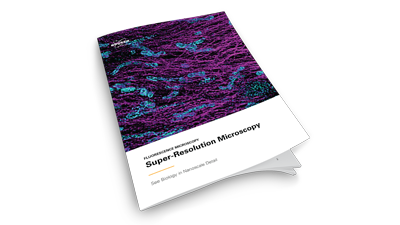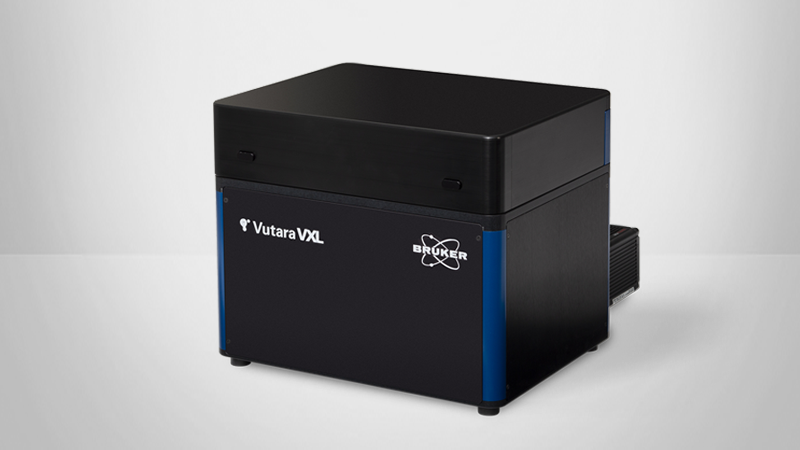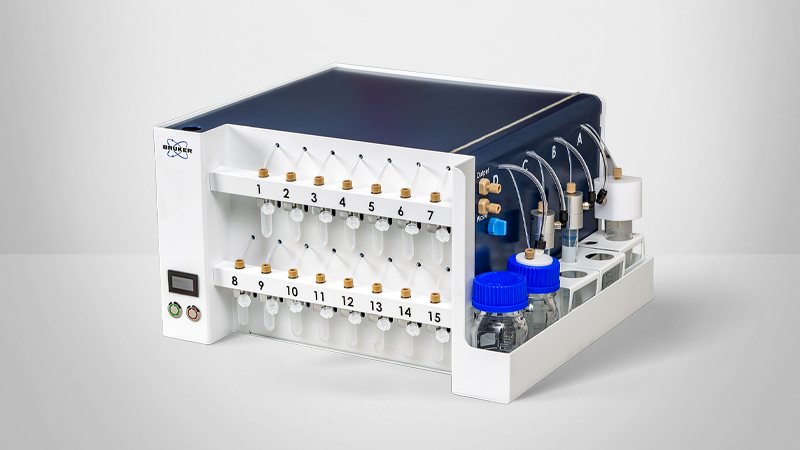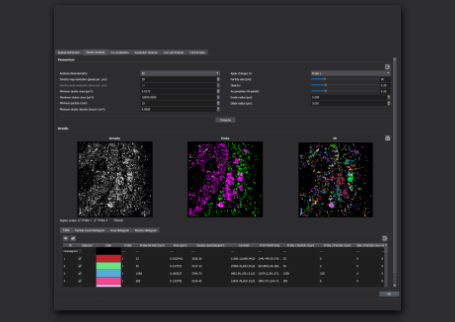Imaging Extracellular Vesicles with Super-Resolution Microscopy
A Powerful New Tool for Imaging Extracellular Vesicles
TABLE OF CONTENTS:
- Answer Key Questions in EV Research
- Measure the Size of Single EVs
- Profile the Molecular Cargo of Single EVs
- Track the Cellular Uptake of EVs
- Discover Actionable EV-Based Biomarkers
- Overcome Traditional EV Research Limits
- Simplify Your EV Research Processes
- FAQ
- Additional Resources
- Our EV Research Solutions
Single-molecule localization microscopy (SMLM) enables high-resolution imaging of extracellular vesicles (EVs). It allows highly accurate quantification of their size, molecular content, and cellular uptake/cargo transfer processes.
In doing so, SMLM:
- Overcomes the limitations of traditional EV imaging methods, and
- Achieves the accuracy and specificity researchers need to expand our understanding of EVs, their role in intercellular communication, and their contribution to pathologies.
Continue reading, contact us, or see the Vutara VXL SMLM microscope to learn more.
Answer Key Questions in EV Research
Resolving the size and composition of single EVs is critical to answering open questions in the study of EVs and understanding their potential therapeutic and clinical uses.
Super-resolution microscopy can distinguish between membrane proteins and internal cargo. It can determine the composition of EV cargo. It uniquely supports contemporary EV research focused on: (1) exploring the role EVs play in cellular communication and (2) the mechanisms and molecules behind EV deployment, release, uptake, and impact on the biochemical function and behavior of cells.
Researchers exploring these topics primarily seek to answer two questions:
- What type of EV is a particular cell making and releasing? and
- Where do those EVs go (e.g., what types of recipient cell(s) do they enter and what are the consequences of their uptake into those cell types)?
Measure the Size of Single EVs
To a large extent, EV subgroups are determined by particle size, which may also play a role in cellular uptake. For example, the upper size limit for clathrin-mediated endocytosis of EVs is near 200 nm. Accurate and reproducible nanometer-scale measurements across all EV subgroups are essential to characterizing EVs and advancing our understanding of EV biology.
SMLM offers a uniquely reliable and practical method for sizing EVs. It enables researchers to easily differentiate and classify EV particles and calculate particle size distribution (PSD).
SMLM is a unique EV imaging method capable of:
- Sizing EVs down to 20 nm (or slightly less) — a capability critical to the characterization of exosomes;
- Accurate differentiation and measurements across a wide range of particle sizes; and
- Imaging and analyzing vesicles in isolation or in cells (in culture or tissue).
Profile the Molecular Cargo of Single EVs
Molecular cargo content is a key point of interest in leading EV research; the effect EV uptake has on the biochemical function and behavior of destination cells is directly related to the composition of its molecular cargo. As a result, highly accurate molecular content/composition characterization is essential for exploring questions about the mechanisms of EV-mediated cellular communication.
SMLM provides highly accurate content data for single EVs
Using immunofluorescent labeling to target membrane proteins and cargo, SMLM can both visualize and quantify specific membrane proteins and determine the composition of a given vesicle’s molecular cargo (e.g., proteins, DNA, RNA, and lipids) — information that traditional methods of EV imaging are unable to determine on a single EV level.
Given that EVs can contain various cargos, ongoing research will involve methodologies such as proteomics or sequencing used in conjunction with super-resolution microscopy. These combined protocols will be especially relevant to discovering the complete composition of EVs generated by specific cells.
Track the Cellular Uptake of EVs
The mechanisms contributing to EV uptake and the biology underlying cargo transfer between cells may have significant implications for disease pathologies. Our understanding of these mechanisms has, until now, been constrained by the capabilities of traditional EV measurement techniques.
SMLM provides the consistency, resolution, and single-molecule sensitivity needed to detect, track, and study EV uptake and cargo transfer.
Its capabilities include:
- Monitoring the uptake of EVs of known composition into cells;
- Tracking EV release and uptake from cells of interest to target cells;
- Identifying EV components that promote their uptake and functional cargo transfer; and
- Visualizing and analyzing the uptake and processing mechanisms of specific EVs and EV subpopulations, differentiated by size and molecular cargo content.
These activities can provide insight into the mechanisms and molecules that initiate and impact selectivity for entry, entry processes, and the fate of EVs once they enter cells. Such insights may contribute to the development of EV-based therapeutics for various pathologies (e.g., cancer metastasis, viral infections, and immune responses) with greater effectiveness than current therapeutic options.
Discover EV-Based Biomarkers of Disease
EV count and cargo might provide important information about the pathophysiology of various diseases. As a result, EVs have the potential to serve as excellent biomarkers, enabling researchers to:
- Clarify the underlying pathogenic mechanisms of diseases;
- Screen and diagnose diseases, particularly those in the early stages of pathogenesis and cancers of unknown origin; and
- Develop new and better therapeutic options.
SMLM may be helpful in revealing actionable biomarkers
With its unique combination of capabilities — particularly to detect, classify, size, count, track, and determine the contents of EVs at the single-vesicle level — SMLM is an ideal EV research method for the discovery of EV-based biomarkers.
Overcome the Limitations of Traditional EV Research Methods
Compared to SMLM, traditional methods of measuring EVs suffer from functional and practical limitations that can complicate and even prevent their use, particularly in novel applications and for exploring new research questions.
For example, electron microscopy (EM) and diffraction-limited fluorescence (confocal and widefield) microscopy are well-established and accessible methods for imaging single EVs. However, although EM allows accurate size measurement with high resolution, its ability to label and image specific molecular content is lacking. Conversely, diffraction-limited fluorescence microscopy can image molecular content with specificity, but it cannot be used to accurately measure EV size. Furthermore, diffraction-limited modalities do not provide the necessary resolution to evaluate target distribution within individual Evs.
See the full table of the capabilities and limitations of measurement methods, below.
| Measurement Capabilities | ||||||||
| Single Vesicles | Bulk EVs | Vesicle Size | Cargo | Target Distribution in Single EVs | EVs in Individual Cells | Accuracy | Minimum Target Size | |
Super-Resolution Microscopy/SMLM | ✓ | ✓ | ✓ | ✓ | ✓ | Highly accurate | Down to 20 nm | |
| Nanoparticle Tracking Analysis (NTA) | ✓ | ✓ | ✓ | Often over-estimates | Down to ~100 nm | |||
| Electron Microscopy (EM) | ✓ | ✓ | EM fixation < 20 nm can reduce | <20 nm | ||||
| Tunable Resistive Pulse Sensing (tRPS) | ✓ | Often over-estimates | Down to 40 nm | |||||
| Dynamic Light Scattering (DLS) | ✓ | Often over-estimates | Down to 50 nm | |||||
| Flow Cytometry | ✓ | ✓ | Down to 50 nm | |||||
| Western Blotting | Proteins only | |||||||
| Mass Spec | Proteins only | |||||||
| Sequencing (RNA, DNA) | RNA/DNA only | |||||||
Simplify Your EV Research Processes
SMLM offers researchers a unique single-instrument solution for the study of EVs. Its combination of resolution, accuracy, and functionality enables highly precise imaging and analysis of individual EVs in order to count, size, measure cargo, and track the fate of particular EVs without requiring additional instrumentation or methodologies.
It is important to note that appropriate fluorescent labeling for super-resolution microscopy studies does require knowledge of potential protein content. This does not present a significant obstacle to the application of SMLM for EV research as all EVs appear to have one or more of the tetraspanin family of proteins (e.g., CD9, CD63, CD81) in their membranes. These are well-accepted, typical EV markers for fluorescent microscopy studies (including super-resolution microscopy).
SMLM provides a single measurement modality for:
- Measuring EVs on an individual basis, either in isolation or with respect to spatial distribution in cells (for EVs derived from cells, tumors, plasma, and other samples);
- Imaging and quantifying EVs in terms of size, membrane protein phenotype, and cargo; and
- Evaluating the three-dimensional relationship of targets in individual EVs.
Frequently Asked Questions
Reliably identifying the type of EVs created in a particular cell can be accomplished through the single-molecule localization measurement of isolated EVs, like those harvested from the extracellular fluid of cultured cells or present in body fluid samples.
Yes, SMLM can be used to obtain accurate and reproducible nanometer-scale size measurement for all EV subgroups — including apoptotic bodies (500 - 2000 nm diameter), microvesicles (100 - 1000 nm diameter), and exosomes (40 - 100 nm diameter).
Identification of proteins in unknown EVs will require proteomics techniques used in conjunction with super-resolution microscopy. These combined protocols will be especially relevant to discovering the complete composition of particular EVs generated by particular cells.
It is also interesting to speculate how sequential labeling techniques such as DNA-PAINT, may be used to create multiplexed views of proteins in known EVs, as well as provide a screening tool for EVs of unknown origin. Nucleotide macromolecules (DNA and/or RNA) can also employ sequence-specific labeling strategies such as oligoSTORM. The determination of the sequence would be required; once determined, SMLM could be used on an individual EV basis.
Using immunofluorescent labeling to target membrane proteins and cargo, SMLM can both visualize and label specific membrane proteins and determine the composition of a given vesicle’s molecular cargo. For cargo containing nucleotides, fluorescent labeling with oligo can be employed.
Evaluating cell entry and its consequences can be accomplished with SMLM via acquiring high-resolution images of cells, either in culture or in tissues, followed by fluorescence labeling of single EVs with a known composition. This allows researchers to identify and track any particular EV's uptake and its molecular cargo's fate.




